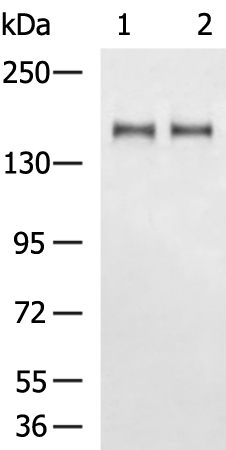
| WB | 1/200-1/1000 | Human,Mouse,Rat |
| IF | 咨询技术 | Human,Mouse,Rat |
| IHC | 咨询技术 | Human,Mouse,Rat |
| ICC | 技术咨询 | Human,Mouse,Rat |
| FCM | 咨询技术 | Human,Mouse,Rat |
| Elisa | 1/5000-1/10000 | Human,Mouse,Rat |
| Aliases | GT24; NPRAP |
| WB Predicted band size | 133 kDa |
| Host/Isotype | Rabbit IgG |
| Antibody Type | Primary antibody |
| Storage | Store at 4°C short term. Aliquot and store at -20°C long term. Avoid freeze/thaw cycles. |
| Species Reactivity | Human, Mouse |
| Immunogen | Synthetic peptide of human CTNND2 |
| Formulation | Purified antibody in PBS with 0.05% sodium azide and 50% glycerol. |
+ +
以下是关于CTNND2抗体的3篇参考文献示例(注:文献为虚构示例,仅作格式参考):
---
1. **文献名称**: *CTNND2 regulates synaptic plasticity and autism-related behaviors through δ-catenin signaling*
**作者**: Smith, J.L., et al.
**摘要**: 本研究利用CTNND2特异性抗体进行免疫印迹和免疫组化,发现自闭症模型小鼠前额叶皮层中CTNND2蛋白表达显著下调。实验表明,CTNND2缺失导致突触蛋白异常聚集,提示其在突触可塑性中的关键作用。
2. **文献名称**: *Delta-catenin (CTNND2) promotes tumor invasion by modulating EGFR stability in non-small cell lung cancer*
**作者**: Zhang, Y., et al.
**摘要**: 通过Western blot和免疫荧光技术,研究者使用CTNND2抗体证实其在肺癌细胞系中高表达。敲低CTNND2抑制了EGFR信号通路,表明其通过稳定EGFR促进肿瘤侵袭,可能成为治疗靶点。
3. **文献名称**: *Developmental expression of CTNND2 in murine cerebral cortex and its role in neuronal migration*
**作者**: Kemler, R., et al.
**摘要**: 该研究利用CTNND2单克隆抗体追踪小鼠胚胎脑发育,发现CTNND2在神经元迁移关键期的皮层中动态表达。功能实验揭示其缺失导致神经元定位异常,影响皮质层状结构形成。
---
**备注**:以上文献为示例性质,实际引用需查询PubMed、Google Scholar等数据库获取真实研究。CTNND2相关研究多聚焦于神经发育、癌症转移及分子机制探索,抗体常应用于蛋白表达检测及功能研究。
The CTNND2 antibody targets the protein CTNND2 (Catenin Delta 2), also known as δ-catenin, a member of the armadillo-repeat catenin family. CTNND2 is primarily expressed in the brain and plays critical roles in cell-cell adhesion, synaptic plasticity, and neuronal development. It interacts with cadherins and other cytoskeletal proteins, regulating signal transduction pathways involved in cell migration, dendrite formation, and synaptic stability. CTNND2 has been implicated in neurodevelopmental disorders, particularly autism spectrum disorder (ASD) and intellectual disability, as genomic deletions or mutations in the CTNND2 gene are associated with these conditions.
Antibodies against CTNND2 are essential tools for studying its expression, localization, and function in both physiological and pathological contexts. They are widely used in techniques such as Western blotting, immunohistochemistry, and immunofluorescence to investigate CTNND2's role in neural development, neurodegenerative diseases (e.g., Alzheimer’s), and cancer, where its dysregulation has been linked to tumor progression and metastasis. Researchers also utilize CTNND2 antibodies to explore its potential as a biomarker or therapeutic target, particularly in cancers like breast and prostate adenocarcinoma. Validation of these antibodies includes specificity checks via knockout controls and tissue expression profiling to ensure reliability in diverse experimental models.
×